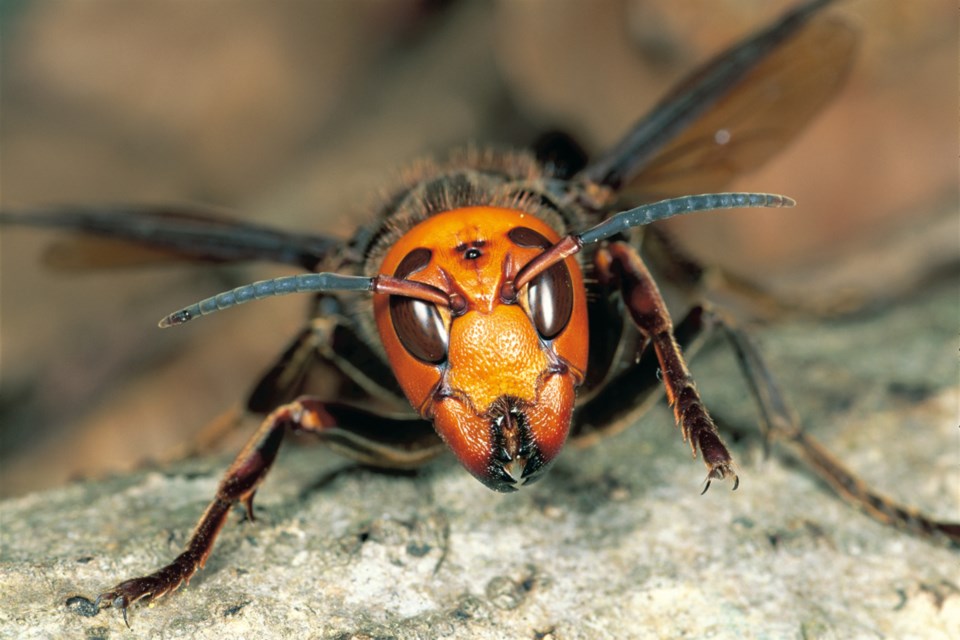In May of 2019, authorities confirmed that several large flying insects found in the Nanaimo area of British Columbia were in fact Vespa mandarinia – the Giant Asian Hornet, also known as the ‘Murder Hornet.’
Specimens of V. Mandarinia were also reported from Washington State.
“2019 would be the first time it was spotted in North America,” said Paul Kozak, Ontario’s head apiarist, with OMAFRA (Ontario Ministry of Agriculture, Food and Rural Affairs). “The theory is it probably arrived with some freight or trade.”
A portion of a hornet’s nest may have been carried to North America, bringing the giant insects, native to Asia, to this side of the Pacific – but “we don’t really know,” Kozak said.
Another unknown: whether the Giant Asian Hornet is now established in the new world.
“Last year, a full-sized nest was found in British Columbia. This year, it’s mostly individuals,” Kozak said – but since the insects captured have been ‘workers’ out foraging, “it indicates it would be an active nest.”
The concern is two-fold. The Giant Asian Hornet, because of its size, delivers a giant dose of venom, making it more dangerous to humans.
Because of the amount of venom, “it takes fewer stings to send a person into toxic shock,” Kozak noted. Giant Asian hornets kill between 40 and 60 people each year in their native range.
But the biggest concern is their threat to honeybee colonies.
Growing up to 5 cm in length, Murder Hornets get their name from their aggressive predation of honeybees.
“They’ll eat the larvae of the honeybees, but they’ll also eat the adults,” Kozak said – biting off the bee’s head and carrying away the body as “a neat packet of protein,” to feed on back in the nest.
The danger to hives depends on the time of year. Early in the season, when the hornets are just building their own nests, individuals may attack a hive and take a bee or two, but the hive itself is generally safe.
It’s late in the season, when the Giant Asian Hornet colony is at its maximum, that bee hives are most at risk.
Looking for “as much protein as they can find,” the hornet colonies will send out scouts to hunt for honeybees, Kozak explained. The scout marks the bee colony with a pheromone, and then returns en masse like an aerial assault team, to attack and “completely kill all the bees in that colony at that time.”
A hive can be totally decimated within a short period of time.
There are “cultural changes” that beekeepers can undertake to protect their bees, including changes to the design of hives, but at this point in time the most important thing is to be watchful, Kozak said.
“We don’t know at this point if they will be successful in establishing a foothold in North America. What we’re talking about at this stage is awareness.”
Monitoring and surveillance are ongoing in both B.C. and Washington State, along with efforts to eradicate any nests or individuals discovered.
At the moment there is no risk to Ontario beekeepers – but as soon as reports of sightings of ‘Murder Hornets’ on the west coast started trending, Kozak starting getting “hundreds” of calls from Ontario residents, worried that they had spotted the giant invaders.
Fortunately, all of the sightings in this province have been of a different hornet species altogether: Vespa crabro, the European Hornet.
Although it has the same coloration as the Giant Asian Hornet – black and reddish-yellow – it is smaller, ranging in size from 2.5 to 3.5 cm.
And although native to the Old World, European Hornets have been in North America for well over 100 years, long enough to become naturalized. They were first found in New York State in the 1800s.
European hornets are social, stinging insects that build large nests and live in colonies, but there are no reports that they pose a risk to either humans or honeybees.
While V.crabro will feed on bees and any other insects they come across, they won’t attack and decimate a hive. Like yellow jackets, spiders, ambush bugs and praying mantises, they are only “intermittent predators” on bees.
Unlike V. mandarinia, which poses a real, long-term threat.
Kozak and his colleagues remain vigilant, keeping a keen watch for Murder Hornets along the west coast – and encouraging residents to call in with their inquiries.
The calls, even when mistaken, are “a good thing,” Kozak said.
“The good news is it’s not here. The other good news is that we have hundreds of people – not beekeepers but ordinary people who are interested,” keeping an eye out for the spread of Murder Hornets and adding to the line of defence.
He encouraged residents to report unusual insect sightings to the Agricultural Information Contact Centre, sending in either a specimen or photo for identification. Photos should be taken from the top, bottom and side, and include an object to indicate relative size.
“We’ve got an entomologist through the University of Guelph,” to ID the insects, Kozak said. Those that aren’t European Hornets usually turn out to be Yellowjacket wasps, Bald-faced hornets (also a wasp), even bumblebees.
There’s another benefit to the calls. They allow Kozak to update the distribution maps for the European Hornet. “We’re receiving a lot of data,” he said, that could indicate the hornets have spread beyond their known range in Ottawa and Eastern Ontario, Toronto and Niagara Region.
So, what’s the difference between a hornet and a wasp, Kozak was asked.
“Hornets are wasps, but not all wasps are hornets,” he said. “True hornets are native to the Old World.”
Inquiries should be directed to OMAFRA’s Agriculture Information Contact Centre, at 1-877-424-1300, or click here.
